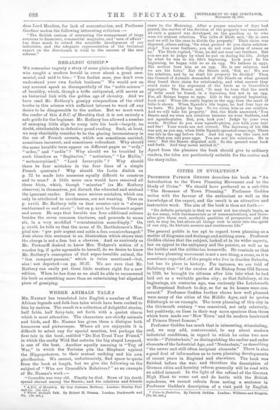HERALDIC GOSSIP.*
WE remember vaguely a story of some plain-spoken dignitary who caught a modern herald in error about a great cere- monial, and said to him : "You foolish man, You don't even understand your own foolish business." We would not on any account speak so disrespectfully of the "noble science" of heraldry, which, though a trifle antiquated, still serves as an historical link with the golden age of chivalry. And we have read Mr. Rothery's gossipy compendium of the chief truths in this science with sufficient interest to ward off any desire to be disagreeable to the author. But we must warn the reader of this A.B.C. of Heraldry that it is not entirely a safe guide for the beginner. Mr. Rothery has allowed a number of annoying little slips to creep into his book—largely, no doubt, attributable to defective proof-reading. Such, at least, we may charitably consider to be the glaring inconsistency in the use of French accents, which are sometimes omitted, sometimes incorrect, and sometimes redundant. Why should the same heraldic term appear on different pages as " nrdy," " urdee," and " urdee"? Why should we be troubled by such blunders as "Sagitarius," " welosines," "Le Mallin," " metamorphised," " Lord Invercylde " ? Why should there be four mistakes in the four lines of a simple French quatrain P Why should the Latin dietich on p. 72 be made into nonsense equally difficult to construe and to scan P A little more care would have removed all these blots, which, though " minutae" (as Mr. Rothery observes) in themselves, yet disturb the educated and mislead the ignorant reader. Even more serious mistakes, which can only be attributed to carelessness, are not wanting. Thus on p. xxviii. Mr. Rothery tells us that counter-vair is " always emblazoned or and azure " : but on p. xxvi. he blazons it argent and azure. He says that heralds use four additional colours besides the seven common tinctures, and proceeds to name six, in a very muddled "concatenation accordingly." On p. xxviii. he tells us that the arms of St. Bartholomew's Hos- pital are: "per pale argent and sable a fess counterchanged." Just above this sentence is an illustration which shows that the charge is not a fess but a chevron. And as anxiously as Mr. Pecksniff desired to know Mrs. Todgers's notion of a wooden leg, if quite agreeable to herself, do we desire to know Mr. Rothery's conception of that super-heraldic animal, the "lion rampant-passant," which is twice mentioned—but, alas ! not depictedon pp. 36-37. We are sure that Mr. Rothery can easily put these little matters right for a new edition. When he has done So we shalt be able to recommend his book as something more than an entertaining but slipshod piece of gossiping.














































 Previous page
Previous page